Offseason trips can be wonderful; it’s easier to book into the best campervan sites, enjoy scenic views with fewer people around and get stuck into seasonal activities. However, chilly evenings can creep in towards the end of the season or even during summer. Combined with the best motorhome dehumidifier, the best campervan heater will keeps you comfortable all year round so you can enjoy touring in all seasons!
Investing in the best heater for a campervan can transform your touring experience, whether you’re adding one to a conversion or upgrading your current setup. Even if your campervan has a gas system, a plug-in electric heater can be ideal for overnight use and it’s always worth considering whether your current heater is still the best option.
We rate electric campervan heaters as the top choice: they’re safe, efficient and affordable. Many feature timers and thermostats and while most oil-filled models provide steady, quiet warmth without drying the air, although they’re bulkier and need more storage. Diesel heaters are another option, but they must be retrofitted and tend to require more maintenance.
These heaters offer supplementary warmth rather than full built-in systems. Most run on corded electric, so a good hook-up is useful or sometimes essential. We’ve focused on low-wattage models for flexibility, from 500W to 1500W.
Whether you’re after an electric heater or an oil-filled alternative, we’ve rounded up top picks from brands like Russell Hobbs, Kampa and De’Longhi.
Practical Motorhome is supported by its audience. When you purchase through links on our site, we may earn an affiliate commission. Learn more.
The best heater for a campervan:
The best electric heater for a campervan:
Russell Hobbs RHPH2001
Schallen Radiator
De’Longhi TRNS0505M Oil Filled Radiator
Dreo Electric Space Heater, 70° Oscillating Portable Heater
Kampa Diddy Portable Heater
Dimplex OFRB7N Eco Chico Mini Radiator
Pro Breeze Mini Heater
Dreo 25 Inch Electric Tower Heater
Campervan heaters – our picks of the best:
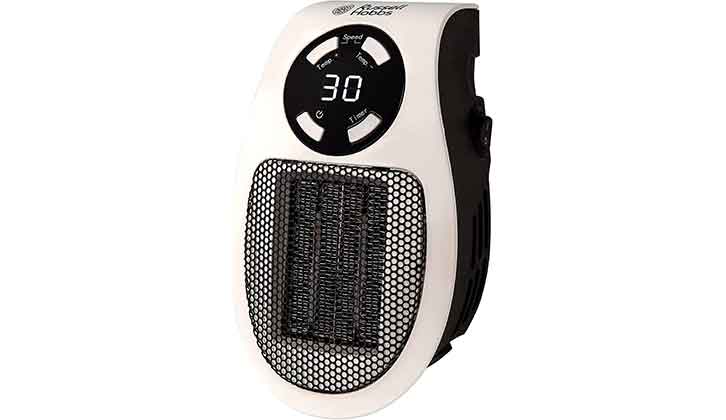
Russell Hobbs RHPH2001
- Dimensions: 4.49 x 4.17 x 7.09 cm
- Weight: 840g
Reason to buy:
- Super compact and can be used anywhere, has a timer
Reason to avoid:
- Not as powerful as other models
If you don’t want to worry about your heater tipping over, or you’ve got a large van to heat but want to keep costs down, these nifty plug-in heaters are perfect. With a 500W maximum output, this is a perfect option for campervanning off-grid, which is safe, cheap to run and can be plugged into any standard socket.
The handy digital display lets you keep an eye on the temperature while the variable thermostat allows you to adjust the level to suit your needs and regulates the heat. One stand out feature which we particularly like is the timer, which allows you to run the fan for up to 12 hours before it automatically turns off. Designed with heat-resistant castors and a handle, you can move the plug without having to wait for it to cool down. Other safety features include tip over and overheat protection.
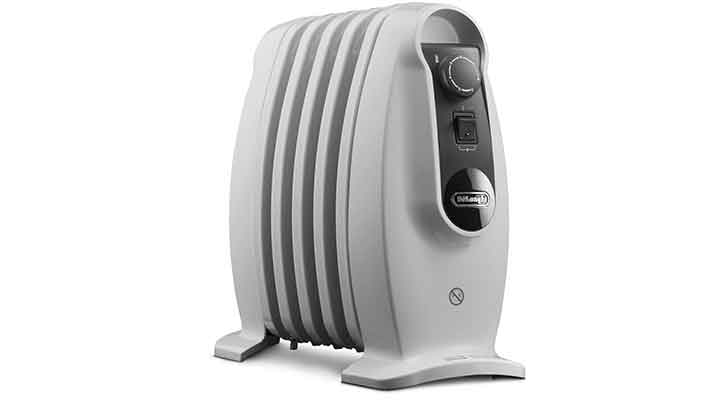
De’Longhi TRNS0505M Oil Filled Radiator
- Weight: 5.5kg
- Dimensions: 38.5 x 17.3 x 34.0 (W x H x D in cm)
Reason to buy:
- Smart appearance, useful carry handles, rounded edges
Reason to avoid:
- Heaviest option in our guide, may be too big for smaller ‘vans
There’s a lot to like about this De’Longhi as a campervan heater. While this doesn’t actually play a part in its effectiveness at keeping you warm, one of our favourite features with it is how smart it looks – with a curved shape, we think if style is an important trait in your buying process, this could be the best campervan heater for you.
The shape offers more than just an injection of style into your ‘van’s interior though – if you inadvertently walk into it, it also helps to keep pain to a minimum. It weighs 5.5kg, which is among the weightier end of the scale of the products in our guide, but carry handles will help you to move it around as required. Coming with an adjustable thermostat too, it’s able to heat a space of up to 15m³. One thing worth considering is whether or not it would be too big for your ‘van, with its dimensions making it quite bulky.
Check the latest price on Amazon now.

Image: Amazon
Dreo Electric Space Heater, 70° Oscillating Portable Heater
- Weight: 1.8kg
- Dimensions: 20.29 x 18.21 x 29.01 cm
Reason to buy:
- Compact yet powerful, delivering quick, even heat with strong safety features
Reason to avoid:
- Best suited for smaller areas so you may struggle to heat larger campervans or open layouts effectively
If you’re short on space, this 26.2cm PTC ceramic campervan heater delivers powerful, efficient warmth in a compact package. Designed for versatility, it fits easily on a surface and features a DC motor and 9-blade system. It produces 1500W of rapid heat plus you can easily set your ideal temperature between 3 and 35°C using the LED display and adjustable thermostat.
70° oscillation distributes heat evenly and it operates at just 40dB, perfect for keeping cosy through chilly nights without disturbing your sleep. The safety design includes overheat and tip-over protection, flame-retardant materials and a reinforced power cord. Plus, the removable washable filter keeps your air clean while supporting an eco-friendly design. With four modes (High, Low, ECO, Fan), you can tailor your warmth and save energy on the go.
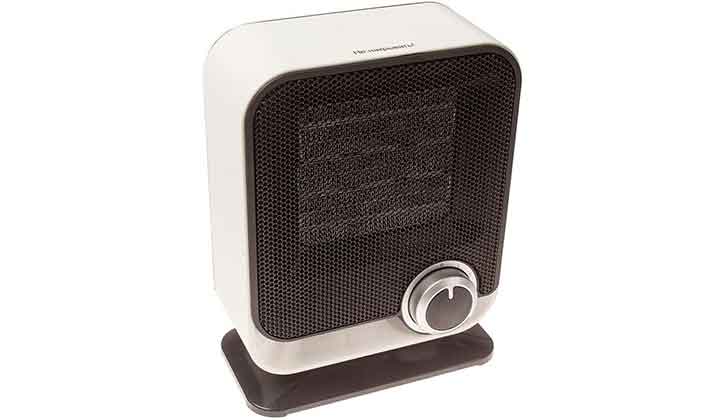
Kampa Diddy Portable Heater
- Weight: 1.16kg
- Dimensions: 13.78 x 11.02 x 13.78 cm
Reason to buy:
- Lightweight and portable
Reason to avoid:
- Probably better suited to smaller spaces
Campervan owners are likely to be familiar with outdoor brand Kampa, which produces a wide range of camping accessories. We think this small and compact product is ideal for anyone who wants a low wattage option that is light in weight. The heater, which weighs only 1.16kg for some excellent portability, comes with a dial that controls the wattage, which can be set to either 750w or 1500w.
The corded option also provides some useful features that we think will give ‘van owners peace of mind, thanks to its thermal overheat protection and a tip over protection switch. It offers an energy-efficient heating element too. However, we’d say it’s probably better suited to those who only want to heat a small area.

Dimplex OFRB7N Eco Chico Mini Radiator
- Weight: 5.4kg
- Dimensions: H44.6, W29.6, D19.4 in cm
Reason to buy:
- Economical to run
Reason to avoid:
- At 5.4kg, it’s fairly weighty
We’d say this Dimplex option is ideal for ‘van owners who want a mid-wattage option. The heater, which has been tested to British Electrotechnical Approvals Board standards, has an output of 700W, while we like how its adjustable dial will offer an efficient way of controlling the temperature. As it is oil-free, it is also a more environmentally-friendly option than an oil-filled heater, as well as providing more efficient heating.
Two things we should point out – it comes to 5.4kg, which means it could be a bit heavy to move around, while its dimensions of 44.6 x 29.6 x 19.4cm could mean it’s not as easy to store as other products in our guide. However, if you have the room and are happy with its weight, it makes a fine option. We like the safety cut function it offers too.
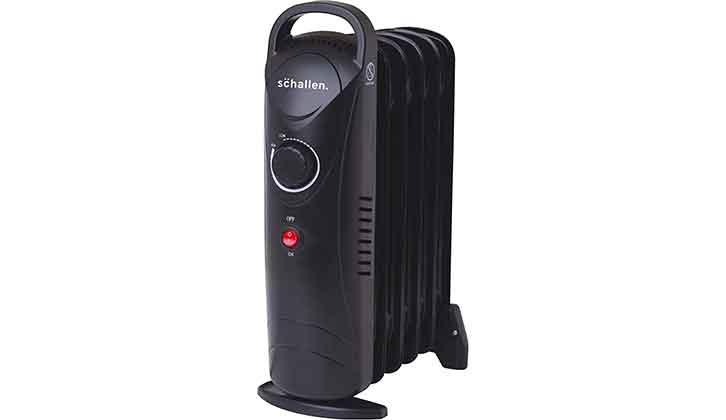
Schallen Radiator
- Dimensions: 15 x 50 x 50 cm
- Weight: 3.42kg
Reason to buy:
- Cheap to run and quieter than fan heaters
Reason to avoid:
- Heavy
For an alternative to fan-assisted heaters, you can try an oil-filled radiator. Also powered by corded electric, this 800W model features 6 oil-filled fins which heat up quickly and provide long lasting heating for your campervan. The sleek design is easily portable, being just 38cm high and 28cm in length and built with a carry handle.
With an adjustable thermostat dial and temperature control, you can leave it on for extended periods of time with the added reassurance of tip-over protection and overheating prevention. Being an oil-filled heater rather than fan, the unit has improved heat retention so you benefit from it even when it’s cooling down.
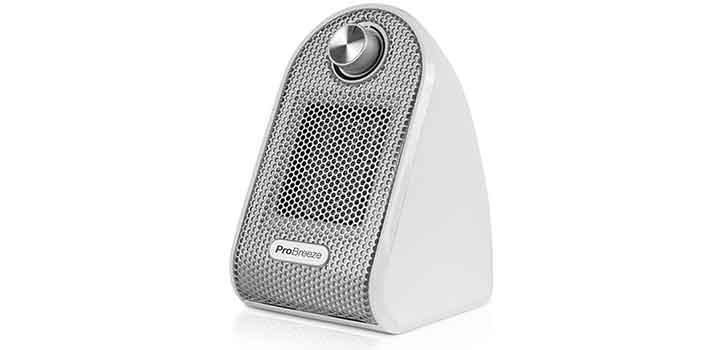
Pro Breeze Mini Heater
- Dimensions: 10.5D x 16.5W x 19H centimetres
- Weight: 710g
Reason to buy:
- Lightweight and compact
Reason to avoid:
- Best suited to small spaces
Running on only 500W, this mini heater provides lightweight portability for anyone who wants a campervan heater with a low wattage and low weight. It comes with some useful features which can provide some valuable peace of mind when it’s in use – for instance, it has an auto-off tip-over switch, as well as overheat protection.
It’s also good to see it comes with an adjustable thermostat, so you can use the dial to reach the right heat for you. It’s also a compact option, so isn’t going to take up much space.
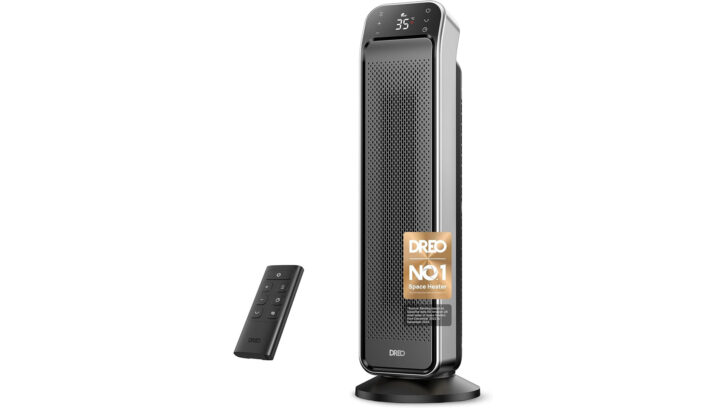
Image: Amazon
Dreo 25 Inch Electric Tower Heater
- Weight: 3.29 kg
- Dimensions: 19.81 x 19.81 x 60.96 cm
Reason to buy:
- Extremely quiet, powerful, and packed with safety features, ideal for larger campervans
Reason to avoid:
- Slightly bulky and pricier than compact models, so may be inconvenient for small campervans or solo travelers
For those seeking premium warmth on the road, the Dreo 25″ Ceramic Space Heater has advanced Hyperamic thermal design and covers areas of 100 – 270 sq ft with 70° oscillation. Its extended impeller doubles the heat range, making it a powerful option for larger campervans, open plan interiors or even adding some heat to an awning. Despite having a 1500W of output similar to smaller campervan heaters, it delivers 11.5ft per second of even heat with the option of 4 modes.
Safety is top-tier with V0 flame-retardant materials, a reinforced plug, 45° tip-over and overheat protection and a child lock. Dreo’s upgraded airflow system runs at just 32dB, keeping nights warm and silent. The precise thermostat lets you fine-tune your temperature from 5 – 35°C with 1℃ accuracy, while ECO Mode automatically adjusts heat to save energy.
What kind of heater is best for a campervan?
If you’re looking for the best heater for a campervan, the right choice depends on your space, setup and how you plan to travel. The right heater can add to your existing motorhome heating system in cooler weather or keep you cosy on chilly summer evenings.
Electric, oil-filled, or diesel?
For most people, the best type of heater for a campervan is an electric heater. They’re safe, efficient and affordable to run, especially on campsites with electric hook-ups. Many models also include timers, thermostats and safety features for peace of mind.
These make a good choice for campervan owners who don’t want to have a diesel or gas system retrofitted into their ‘van, or perhaps want to have heating during the night which doesn’t run on either. They can come as pure electric or oil-filled. Pure electric options are cheap, efficient and generally the safest to use. However, what could make an oil-filled option a more attractive choice is it will not dry the air out as much and is also more likely to operate in a quieter manner. The downside is these are heavier, which could be a payload concern, and also means they don’t offer quite the portability that the fan counterpart provides.
Similarly, gas heaters can be an efficient way to keep a campervan warm in winter. In the winter months, you would need one that runs on propane (which can turn from a liquid to a gas at as low a temperature as -42ºC), instead of butane (which only does it to ‘gassing’ at -2ºC). However, you will need to ensure you have the gas bottle to run it as well as consider taking a spare with you. You will also need have good ventilation for this and a CO detector in your ‘van. Something else we should highlight is that like a diesel option, it will need to be installed in your ‘van.
Diesel heaters provide strong, built-in heating and are perfect for off-grid camping. While they will offer an effective heating solution, these will require installation to run, meaning they don’t add the flexibility to your setup that an electric option would require and can be more expensive upfront. We’d say that generally, these are better suited to those who are in the process of a self-build campervan project.
How to choose a campervan heater?
When choosing the best campervan heater, consider what will make your trips easier and safer. Features like a remote control, tip-over switch or overheat protection can add both comfort and an assurance of safety.
Before you buy, think about where the heater will go inside your campervan. Space is often limited, so measure carefully and choose a model that fits your layout. Compact electric campervan heaters are ideal for smaller interiors, but make sure you also have room to store the heater when it’s not in use.
Whether you choose an electric, oil-filled or diesel campervan heater, the best option for you will balance efficiency, size and convenience. With the right campervan heater, you’ll stay warm wherever and whenever you travel.
Do 12v car heaters really work in a campervan?
We’d be reluctant to advise you to rely on a plug-in 12v car heater for your campervan for the simple fact that these are incredibly unlikely to be able to provide the necessary power to heat up a space as big as a campervan. As a result, we wouldn’t recommend a 12v electric campervan heater. These are likely to be too weak to warm your ‘van and we wouldn’t consider this a worthwhile investment.
How do I keep my campervan warm at night?
Whether you opt for the best electric heater for a campervan, a 12v, or a diesel option, you should have an efficient way of beating the chill in your ‘van. However, there are some other tips we’d advise to help you keep touring during the cooler weather and stay warm at night.
As a starting point, we’d suggest ensuring you are insulating the floor beneath both the sofas and (if it has a fixed bed), the beds. This can be done by using carpet or another type of insulation material. You could consider adding lagging to the wheel arches and the gas-locker bulkheads too.
However, one thing you want to avoid doing is blocking the drop-out vents in the floor; these are important for letting propane and butane gases escape, on the off chance you have a leak.
The cab is the area that’s likely to lose the most amount of heat overnight, so if you only have standard blinds, you could consider adding thermal external screens, too.
Additionally, if you’ve got a pop-up roof, you could consider dropping it overnight during the very coldest of weather.
Written with contributions from Peter Byrne and Sarah Wakely
If you’ve enjoyed reading this article, why not get the latest news, reviews and features delivered direct to your door or inbox every month. Take advantage of our brilliant Practical Motorhome magazine SUBSCRIBERS’ OFFER and SIGN UP TO OUR NEWSLETTER for regular weekly updates on all things motorhome related.
Leave a Reply